Chokecherry Tree: Leaves, Chokecherries, Flowers (With Pictures) – Identification
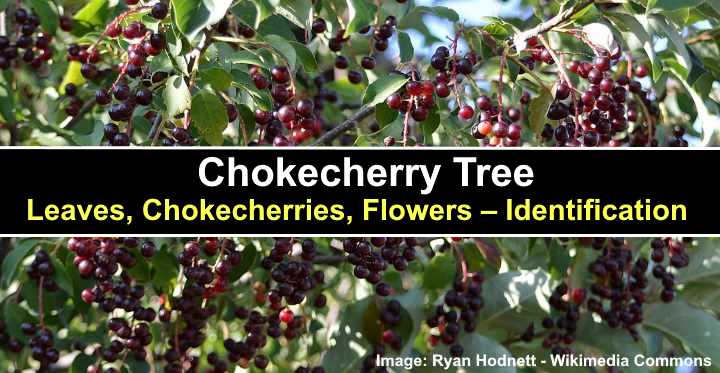
Chokecherry is a deciduous suckering shrub or small, bush-like tree with clusters of white spring flowers and astringent reddish-purple berry-like edible fruits. Chokecherry shrubs usually grow up to a maximum of 30 ft. (9 m) tall and have a rounded, irregularly shaped crown. Other identifiable features of chokecherry plants are relatively smooth gray bark, glossy green egg-shaped leaves, white spring flowers, and dark red or black summer fruits.
This article is a guide to identifying chokecherry shrubs and trees in the landscape. Pictures and descriptions of chokecherry bush leaves, fruit, bark, and flowers will help to recognize these deciduous shrubs in the landscape.
Chokecherry Tree Facts
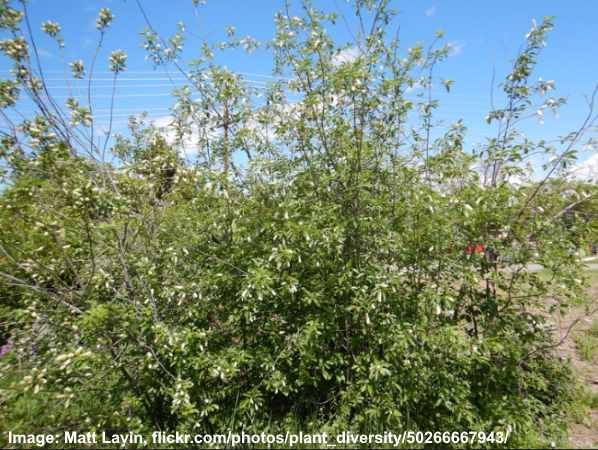
Chokecherry tree (Prunus virginiana) is a suckering shrub-like tree
Chokecherry (Prunus virginiana) is a small perennial tree or multi-stemmed shrub that sends up suckers. The fruit-bearing trees or shrubs are common throughout the northern states of the US and Canada. Chokecherry trees are known for their tart, bitter, berry-like drupes and are used to make jams and jellies.
The chokecherry belongs to the genus Prunus which has other trees and shrubs that produce drupes. Chokecherry trees are closely related to the North American black cherry (Prunus serotina). However, the chokecherry fruits, leaves, and plant size are somewhat smaller.
Typically, a chokecherry shrub grows between 3 and 20 ft. (1 – 6 m) tall and up to 20 ft. (6 m) wide. However, it’s not unusual for some chokecherry trees to reach 30 ft. (9 m) tall. In a landscape, the sizeable suckering shrub has an oval, rounded crown that is somewhat irregular.
As a cold-hardy shrub or tree, the chokecherry thrives in USDA zones 2 through 10. The attractive flowering plant grows best in full sun or part shade. For best results, the chokecherry should be planted in slightly moist or dry well-drained soil. However, when established, chokecherry is tolerant of drought.
The common name chokecherry comes from the bitter taste of the drupes. Prunus virginiana also goes by the names Virginia bird cherry, bitter-berry, American chokecherry, and black chokecherry.
It’s also good not to confuse chokecherry (Prunus virginiana) with another shrub that produces tart fruits—chokeberry (Aronia). Although they sound similar, chokeberries belong to a different genus, and their fruits are pomes, not drupes.
Are Chokecherries Edible?
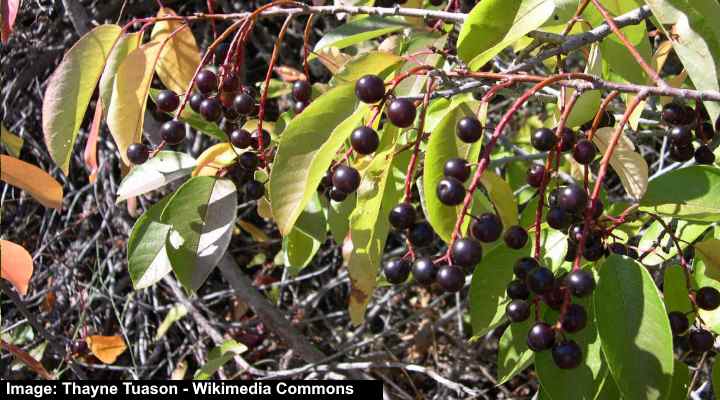
The flesh of Chokecherry berry-like fruit is edible but very tart, however don’t eat the seeds that contain toxins
The chokecherry tree produces small edible fruits called drupes. The fruit from chokecherry is edible but it’s extremely tart when consumed raw, especially unripe chokecherries. The only way the “cherry” will “choke” you is due to its highly astringent taste that can cause your mouth to pucker. The pea-sized fleshy fruits have a stone in the center.
As a word of caution, other parts of the chokecherry tree—the seeds, leaves, and stems—are toxic and shouldn’t be eaten.
Chokecherry Leaves
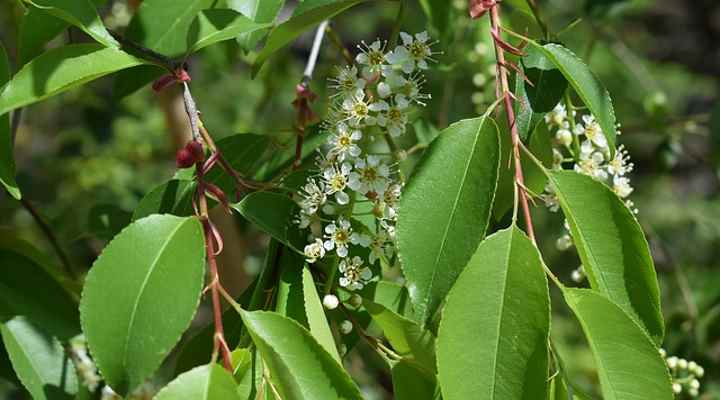
Chokecherry leaves
Chokecherry tree leaves are identified by their ovate or egg shape with serrated margins and tapering points. Chokecherry leaves measure between 3” and 6” (7.5 – 15 cm) long and 1” to 3” (2.5 – 7.5 cm) wide. A recognizable feature of the oval pointed leaves is that they release a strong, bitter scent when crushed.
Another way to identify chokecherry is by the leaf color. The top side of the ovate leaves is a dark, glossy green color. The underside of the leaf is a lighter green with fine white or yellow hairs. Also, look for fine serration along the leaf’s edges and a pointed tip.
Chokecherry leaves are yellow, golden-orange or reddish in the fall. However, the chokecherry tree cultivar ‘Schubert’ has purple leaves that turn bright red in the fall.
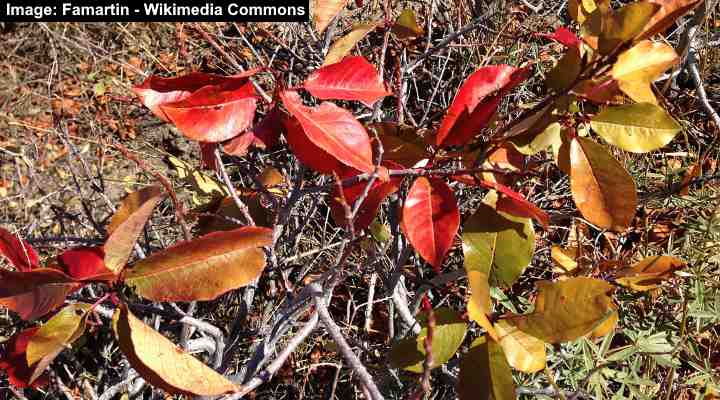
Chokecherry autumn foliage
One way to tell a chokecherry tree apart from a black cherry tree is the size and type of leaf. Unlike black cherry tree leaves that are smooth with blunt edges, the chokecherry has fine teeth running along the edges. Also, the chokecherry leaf is hairier than black cherry leaves.
Chokecherry Bark

Chokecherry bark
Chokecherry tree bark is identifiable by its gray smooth surface and horizontal white lenticels that look like small raised bumps. The thin bark develops shallow grooves or fissures as the tree matures.
Looking at the bark helps to identify chokecherry trees from other types of cherry trees. Chokecherry bark is a characteristic gray color rather than reddish-brown. Additionally, the lenticels on chokecherry are not as pronounced as on other cherry trees.
Chokecherry Blossoms
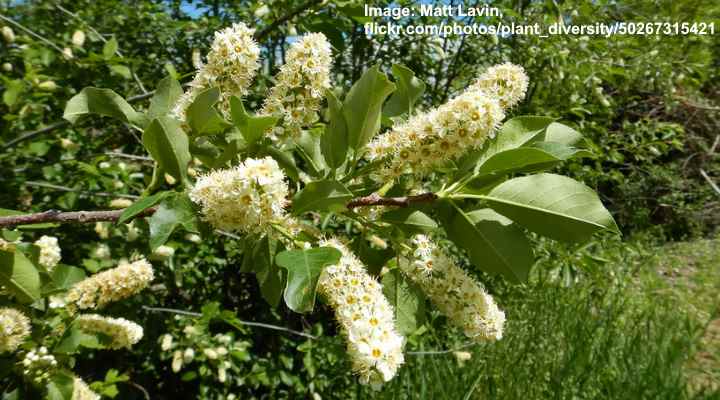
Chokecherry flowers
Cylindrical clusters (racemes) of five-petaled white flowers help to identify chokecherry trees. The showy chokecherry racemes measure 2” to 4” (5 – 10 cm) long. Each cluster consists of between 20 and 50 pretty white flowers. Individual cup-shaped flowers have five rounded petals and a yellow-orange center.
Chokecherry trees are identifiable when the flowers blossom in mid-spring. The white and yellow cylinder-like flower clusters fill gardens with a pleasant, fragrant aroma.
Chokecherry Fruit (Chokecherries)
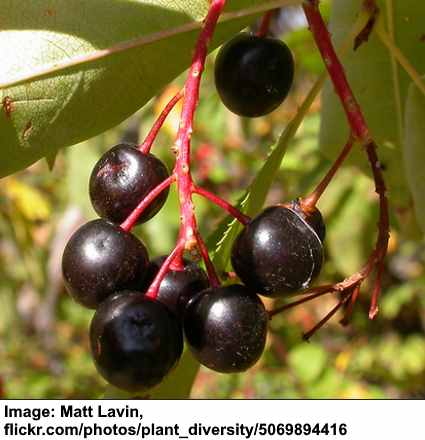
Chokecherry fruit
Chokecherry tree fruit is recognizable as bunches of small, pea-sized reddish-purple berry-like drupes measuring 0.2” to 0.4” (0.5 – 1 cm). Also called chokecherries, the red berries ripen to dark purple in late summer. In summer, it’s easy to identify chokecherry shrubs by the clusters of red or purple “berries.”
Red chokecherries tend to be too tart and bitter to eat. However, you can recognize ripe chokecherries by their dark color when ready to eat. Although ripened chokecherries still have an astringent taste, many people like eating fresh “berries” straight off the tree.
Chokecherry Seeds
Each chokecherry drupe contains a relatively large seed. The round seed can be up to half of the drupe’s volume. It’s vital to note that chokecherry seeds contain toxins and shouldn’t be eaten. The best way to use chokecherry seeds is to harvest them then use them to plant new trees the following spring.
Is Chokecherry Poisonous?
Most parts of the chokecherry tree are poisonous to humans and animals. Ingesting chokecherry seeds, leaves, stems, and bark releases hydrocyanic acid, known as cyanide. Eaten in large quantities, the seeds can be fatal. However, the fleshy part of chokecherries is not toxic, and you can safely eat the juicy fruits without the stones.
Chokecherry Identification
Identify a chokecherry tree by the leaves, flowers, and fruit. Chokecherry trees are recognizable by their dark green, ovate leaves with finely serrated margins and pointed tips. Also, look for cylindrical clusters of white spring flowers. In summer, chokecherry shrubs are identified by clusters of red or purple pea-sized fruits.
Chokecherry Tree
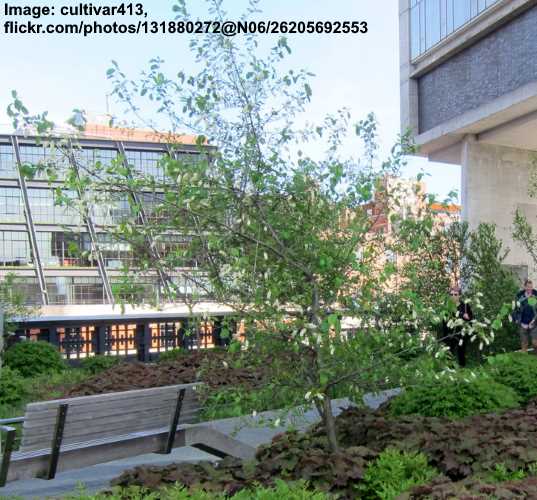
You can remove suckers around the central trunk to grow a single-stemmed chokecherry tree
The chokecherry tree is a fruit-bearing leafy plant, growing up to 20 ft. (6 m) tall. The chokecherry is a perennial, deciduous suckering plant, which commonly grows as a multi-stemmed shrub. However, you can grow a single-stemmed chokecherry tree by removing the suckers that appear around the central trunk.
What is Canada Red Chokecherry?
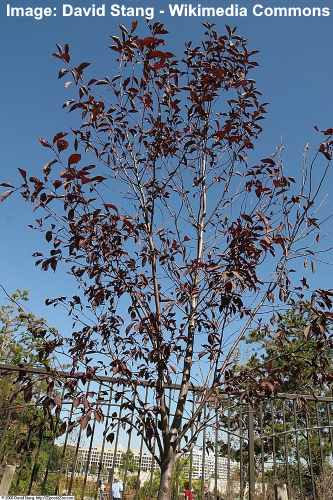
Prunus virginiana ‘Canada Red’
The Canada red chokecherry is an ornamental tree or shrub with spectacular reddish-purple foliage. The tree’s arching branches grow into an attractive rounded canopy that reaches 25 to 30 ft. (7.6 – 9 m) tall and 15 to 20 ft. (4.5 – 6 m) wide.
Like the regular chokecherry tree, the Canada red variety has clusters of small white showy flowers that blossom in spring. After pollination, the flowers develop into tart, dark edible drupes that are delicious when used in sauces, preserves, and jellies.
Chokecherry Tree Uses in the Landscape
The chokecherry tree is an attractive landscape tree suitable for growing in front or backyards. The appealing rounded crown, green leafy foliage, white spring flowers, and dark berries give the tree plenty of appeal as a specimen tree or lawn tree.
As a suckering shrub, chokecherry is suitable as a flowering hedge, privacy screen, or windbreak. Apart from the shrub’s beautiful foliage and flowers, the abundant berries it produces in late summer and fall is another reason to plant a chokecherry tree.
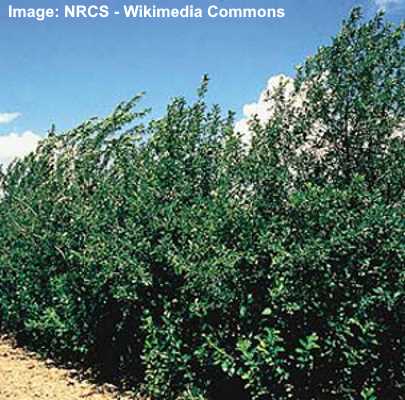
Chokecherry hedge
When considering planting a chokecherry shrub or tree, there are a few factors to consider. First, its foliage, seeds, and twigs are toxic to many animals. So, if you have pets, then you should take this into account. Second, the chokecherry fruit attracts deer who like to feed on them. So, if deer are a problem in your area, you may want to consider another type of flowering tree, thorny shrub, or deer-proof plant.
Chokecherry Tree Care
Let’s look in detail at how to care for a chokecherry tree growing in a garden landscape.
Where to Plant Chokecherry Tree in a Garden Landscape
A chokecherry tree thrives where it gets at least six hours of sunlight daily. Growing in full sun is vital to encourage healthy foliage, flowers, and berries. However, chokecherry should perform well in partial shade, but you may notice that flowering isn’t as abundant if there is too much shade.
When choosing where to plant a common chokecherry shrub or bush, ensure that the ground is well-draining. Chokecherry plants thrive in fertile, dry to medium moist soil. It’s good to note that chokecherry trees can survive on a minimal amount of water. However, the soil should retain some moisture to ensure plenty of berries.
Growing Chokecherries in Containers
Chokecherry shrubs also grow well in containers on patios, decks, or paved yards. Potted chokecherry plants have the same showy white flowers and tart reddish-purple fruit as trees planted in the ground. Additionally, the pot size will control its height—ideal for small, compact gardens. For example, a chokecherry bush in a container will grow up to 12 ft. (3.6 m).
Here are a few handy tips when planting a chokecherry bush in a container:
- Use a light, sandy potting mix that holds moisture well
- Water the potted chokecherry whenever the top layer of soil is dry
- Ensure the soil and container drains well and place the shrub in full sun or partial shade
- Fertilize the shrub regularly in the growing season to encourage blooming and fruiting
How to Water Chokecherry Tree
Water a chokecherry tree twice a week during the growing season if there is no rainfall. However, with mature, well-established trees, you can water less frequently. Adequate irrigation is essential to ensure excellent fruit quality.
Chokecherry trees are drought-tolerant plants. The trees can survive dry periods without any water or rainfall. However, a chokecherry tree won’t produce as much fruit in hot summers if the ground is too dry. On the other hand, roots standing in soggy ground for too long tend to rot and affect the plant’s growth.
Top tip when watering a chokecherry tree: Always water the ground and avoid splashing water on foliage to prevent powdery mildew or other signs of foliage fungal infections.
How to Plant Chokecherry Tree
The best time to plant a chokecherry tree is in spring or fall. Planting at this time allows the chokecherry roots to become established before hot summer weather arrives. When planting, space chokecherry trees at least 5 to 8 feet apart (1.5 – 2.4 m). This ensures good air circulation and healthy growth. Remember to choose the sunniest spot in your garden to plant the tree or shrub.
To plant a chokecherry tree or shrub, dig a hole that is the same depth as the root ball and twice its width. Place the root ball in the center and back-fill the remaining space with soil, firming it as you go to remove air pockets. Once filled in, thoroughly water the ground to let the soil settle.
After planting a chokecherry tree, add 4” to 6” (10 – 15 cm) of bark mulch or a mulch alternative over the root area. Mulching helps protect the roots from the heat and cold and prevents weeds.
Pruning a Chokecherry Tree
Pruning a chokecherry tree or shrub is crucial to encourage healthy growth and plenty of summer berries. Because it’s a suckering shrub, you must remove shoots to prevent the chokecherry tree from growing as a bush. In early spring or winter, remove all shoots and the lower branches from the stem or root area.
When growing a chokecherry shrub, pruning helps to train the plant to grow as an attractive bush. In winter or early spring, cut back about one-third of old growth to encourage blooming, berries, and a pleasing shape.
It’s good to remember that fruit grows on young wood, so removing old wood every year helps to ensure a bumper harvest of “berries.”
Chokecherry Tree Fertilization
Fertilizing a chokecherry tree is helpful to promote blooming, good fruit production, and disease resistance. It is best to use a balanced tree fertilizer each spring to boost growth. Typically, a fertilizer with an NPK rating of 16-16-16 should be sufficient to address the plant’s nutrient requirements.
It’s also advisable to test the soil for nutrients—nitrogen, phosphorus, and potassium—deficiencies. This way, you can determine if you need to apply a specific tree fertilizer to encourage better foliage growth, blooming, or more fruit.
Related reading: How to choose the best fertilizer for shrubs.
Pests Affecting Chokecherry Tree Growth
Chokecherry shrubs and trees attract various pests that can destroy the plant’s foliage. For example, brown hairy tent caterpillars can infest chokecherry trees and defoliate the plants. Aphids are another pest that can feed on the underside of leaves.
You can spot the signs of prairie tent caterpillars and eastern tent caterpillars by the tent-like webbing they form on branches. To get rid of tent caterpillars, remove and destroy the tent-like structures on cool days when the caterpillars occupy the tents. You can also use a natural insecticide like Bacillus thuringiensis (Bt) to kill larvae in their early stages.
Aphids on chokecherry shrubs and trees look like tiny black or green insects on foliage. You can get rid of aphids by turning the garden hose on the leaves to remove the pests physically. Or you can use a horticultural soap or neem oil solution to help reduce the aphid population.
Diseases Affecting Chokecherry Tree Growth
Chokecherry trees are relatively hardy, fast-growing trees that don’t succumb easily to diseases when conditions are right.
Bacterial leaf spot infections such as Xanthomonas prunii and Pseudomonas syringae can cause red or purple spots on leaves and fruit. You can prevent bacterial leaf spot by not over-fertilizing with a nitrogen-rich fertilizer.
Another disease to affect chokecherry plants is X-disease, also called mycoplasma. This disease causes chokecherry leaves to turn a yellowish-green color in July. They then turn dark bronze through August. The only way to cure X-disease is to remove the chokecherry tree or shrub before it spreads.
Suppose you notice sunken cankers on branches or black swellings at the end of branches. In that case, it’s crucial to remove and burn them to prevent the rest of the tree from becoming infected.
Related articles:
